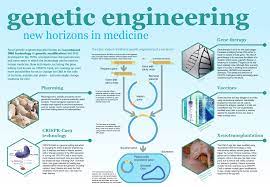Genetic engineering is the direct manipulation of an organism’s genes using biotechnology. It is a relatively new field of science, with the first successful experiments being conducted in the early 1970s. Since then, genetic engineering has revolutionized many fields, including agriculture, medicine, and environmental science.
There are many different techniques used in genetic engineering. One common technique is to use restriction enzymes to cut DNA at specific locations. This allows scientists to insert or remove genes from an organism’s genome. Another technique is to use plasmids, which are small circular pieces of DNA that can be easily manipulated. Plasmids can be used to carry genes into cells, where they can be expressed.
Genetic engineering has a wide range of potential applications. In agriculture, it can be used to create crops that are resistant to pests or diseases, or that have improved nutritional content. In medicine, it can be used to develop new treatments for diseases, or to create vaccines. In environmental science, it can be used to clean up pollution or to develop new biofuels.
Genetic engineering is a powerful tool, but it also raises a number of ethical concerns. Some people worry that genetic engineering could be used to create “designer babies,” or to create organisms that are harmful to the environment. Others worry that genetic engineering could lead to new forms of discrimination.
Despite the ethical concerns, genetic engineering is a promising field of science with the potential to improve the lives of millions of people. As the technology continues to develop, it is important to have a thoughtful and informed discussion about the potential risks and benefits of genetic engineering.
Here are some of the potential benefits of genetic engineering:
- Improved crop yields: Genetically engineered crops can be resistant to pests and diseases, which can lead to increased crop yields. This can help to reduce food insecurity and improve global food security.
- Improved nutritional content: Genetically engineered crops can be modified to have a higher nutritional content, which can help to improve human health. For example, golden rice is a genetically engineered rice that has been enriched with beta-carotene, which is a precursor to vitamin A. Vitamin A deficiency is a major public health problem, and golden rice could help to reduce the number of people who are affected by this deficiency.
- New treatments for diseases: Genetic engineering can be used to develop new treatments for diseases. For example, insulin is a protein that is produced by the pancreas. People with diabetes cannot produce insulin on their own, so they must take it as a medication. Insulin can be produced in a laboratory using genetically engineered bacteria. This has made it possible for people with diabetes to live longer and healthier lives.
- Environmental benefits: Genetic engineering can be used to clean up pollution and to develop new biofuels. For example, genetically engineered bacteria can be used to degrade oil spills. This can help to protect the environment and to reduce the economic costs of oil spills. Biofuels are fuels that are made from renewable resources, such as corn or soybeans. Genetic engineering can be used to improve the efficiency of biofuel production. This could help to reduce our reliance on fossil fuels and to reduce greenhouse gas emissions.
Despite the potential benefits, there are also some potential risks associated with genetic engineering. These risks include:
- The possibility of creating “designer babies”: Genetic engineering could be used to create children with desired traits, such as intelligence, athletic ability, or beauty. This could lead to a new form of discrimination, where people are judged based on their genetic makeup.
- The possibility of creating harmful organisms: Genetic engineering could be used to create organisms that are harmful to the environment or to human health. For example, genetically engineered bacteria could be released into the environment and could become resistant to antibiotics. This could make it more difficult to treat bacterial infections.
- The possibility of unforeseen consequences: Genetic engineering is a relatively new field of science, and we do not fully understand the long-term consequences of manipulating genes. It is possible that genetic engineering could have unintended consequences, such as the creation of new diseases or the disruption of ecosystems.
It is important to weigh the potential benefits and risks of genetic engineering before making decisions about its use. Genetic engineering is a powerful tool, but it is also a tool that should be used with caution.






